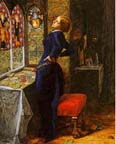 Dante Gabriel Rossetti based his painting Lady Lilith on a sonnet from his poem The House of Life entitled "Body's Beauty." The painting forms a pair with Sibylla Palmifera or "Soul's Beauty", another Rossetti work based on a sonnet by the same title. Together the two works portray a dialectic in ideal beauty: that which is grounded in the physical and that which is spiritual. Lady Lilith sits luxuriously in a sensual environment. Her auburn hair cascades down her voluptuous frame. Her draping dress barely covers her overtly feminine form, revealing her pale shoulders, clavicle, and breasts. As Lilith combs her hair she contemplates her own reflection in a hand mirror. Another mirror in the upper left corner reflects a tree, adding to the ambiguity and mystery of Lilith's surroundings. Like her flowing hair and garments, Lilith is draped over a chair with white roses and poppy's framing her seductive face, but the reflection of the tree makes it unclear to the viewer whether the scene is in or out of doors. The overt sensuality of the painting is clearly grounded in physical beauty and desire, just as the sonnet speaks of the "Body's Beauty."
Dante Gabriel Rossetti based his painting Lady Lilith on a sonnet from his poem The House of Life entitled "Body's Beauty." The painting forms a pair with Sibylla Palmifera or "Soul's Beauty", another Rossetti work based on a sonnet by the same title. Together the two works portray a dialectic in ideal beauty: that which is grounded in the physical and that which is spiritual. Lady Lilith sits luxuriously in a sensual environment. Her auburn hair cascades down her voluptuous frame. Her draping dress barely covers her overtly feminine form, revealing her pale shoulders, clavicle, and breasts. As Lilith combs her hair she contemplates her own reflection in a hand mirror. Another mirror in the upper left corner reflects a tree, adding to the ambiguity and mystery of Lilith's surroundings. Like her flowing hair and garments, Lilith is draped over a chair with white roses and poppy's framing her seductive face, but the reflection of the tree makes it unclear to the viewer whether the scene is in or out of doors. The overt sensuality of the painting is clearly grounded in physical beauty and desire, just as the sonnet speaks of the "Body's Beauty."
Rossetti's sonnet tells of Lilith, who in Talmudic legend was Adam's first wife. She is Rossetti's femme fatal, seducing young men with her feminine whiles and then tossing them off. In the poem she casts her "spell through him, and left his straight neck bent; And round his heart one strangling golden hair." Lilith's beauty is fatal. He who falls for the corporeal sensuality that Lilith represents is doomed.
Questions
1. The contrast between Rossetti's sonnets, "Soul's Beauty" and "Body's Beauty" is clear. One speaks of pure, spiritual, wholesome beauty; the other describes a physical, sensual seduction that leads men to harm. What does this contrast have to do with social and moral expectations of the Victorian era?
2. Lilith's draping hair and her cascading dress almost fill the entire canvas of the painting, making it difficult for the viewer to accurately interpret her surroundings. What effect does the ambiguity of the environment have on the mood of the painting and it's overall impact?

3. Why did Rossetti include a reflection of a tree in the mirror in the upper left-hand corner? What does it symbolize, if anything?
4. Compare Lady Lilith to Millais's Mariana. What do these two women have in common? How is the treatment of their environment similar or different? What significance does the outer surroundings have for these women?
Related Materials
- The Beauty as Power in in Rossetti's Lady Lilith
- The Paradox of Beauty in D.G. Rossetti's Lady Lilith
- The Modern Lilith
Bibliography
The Norton Anthology of English Literature (online) http://www.wwnorton.com/nael/victorian/topic_3/lilith.htm.
Last modified 6 October 2004